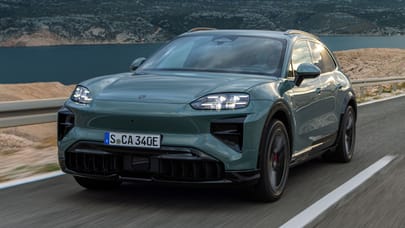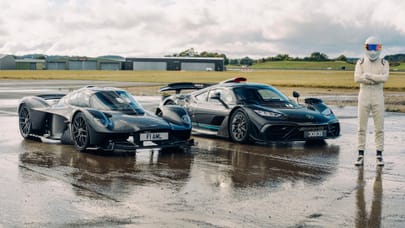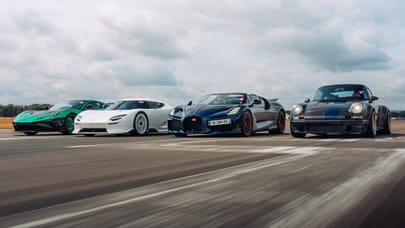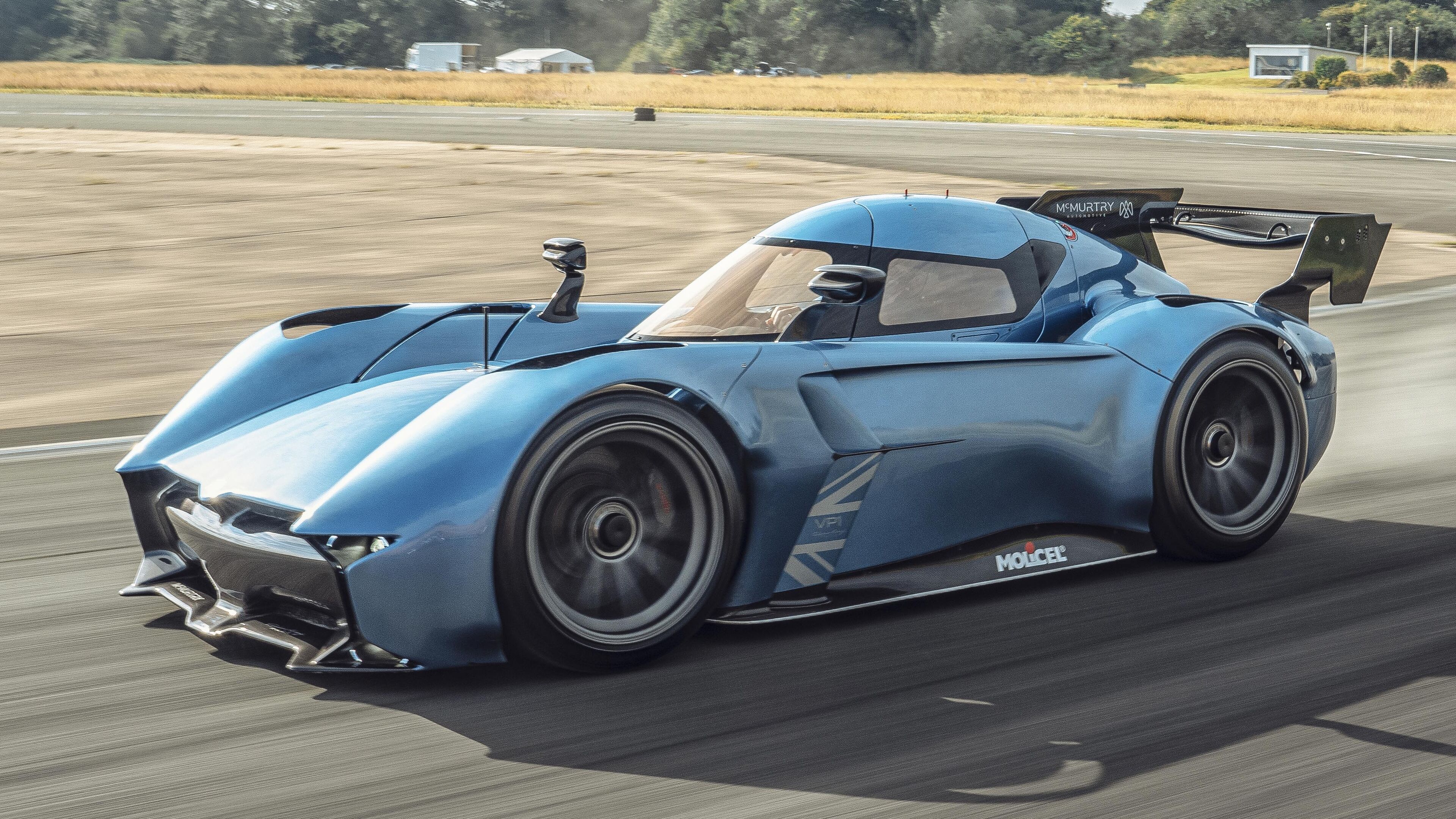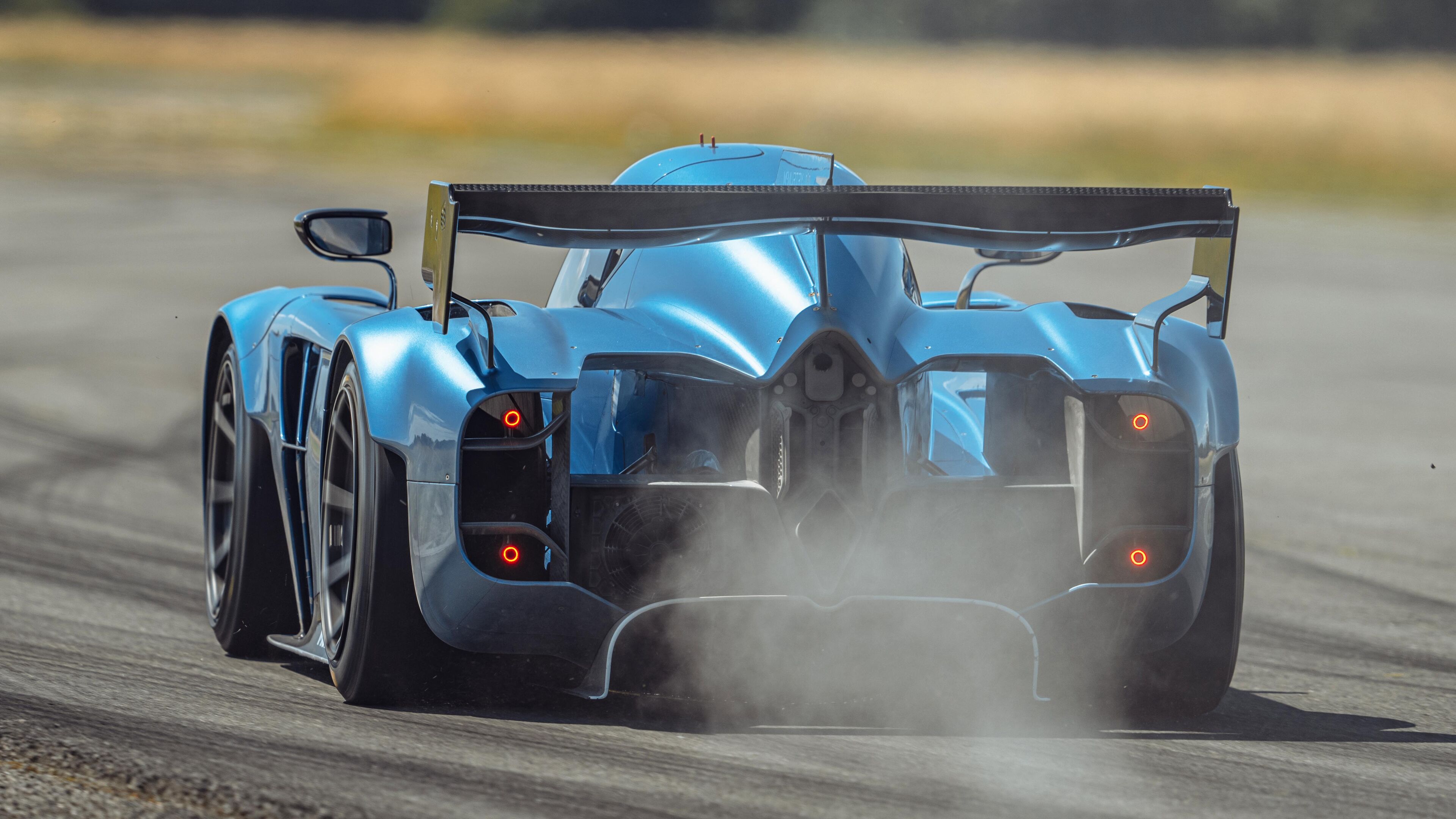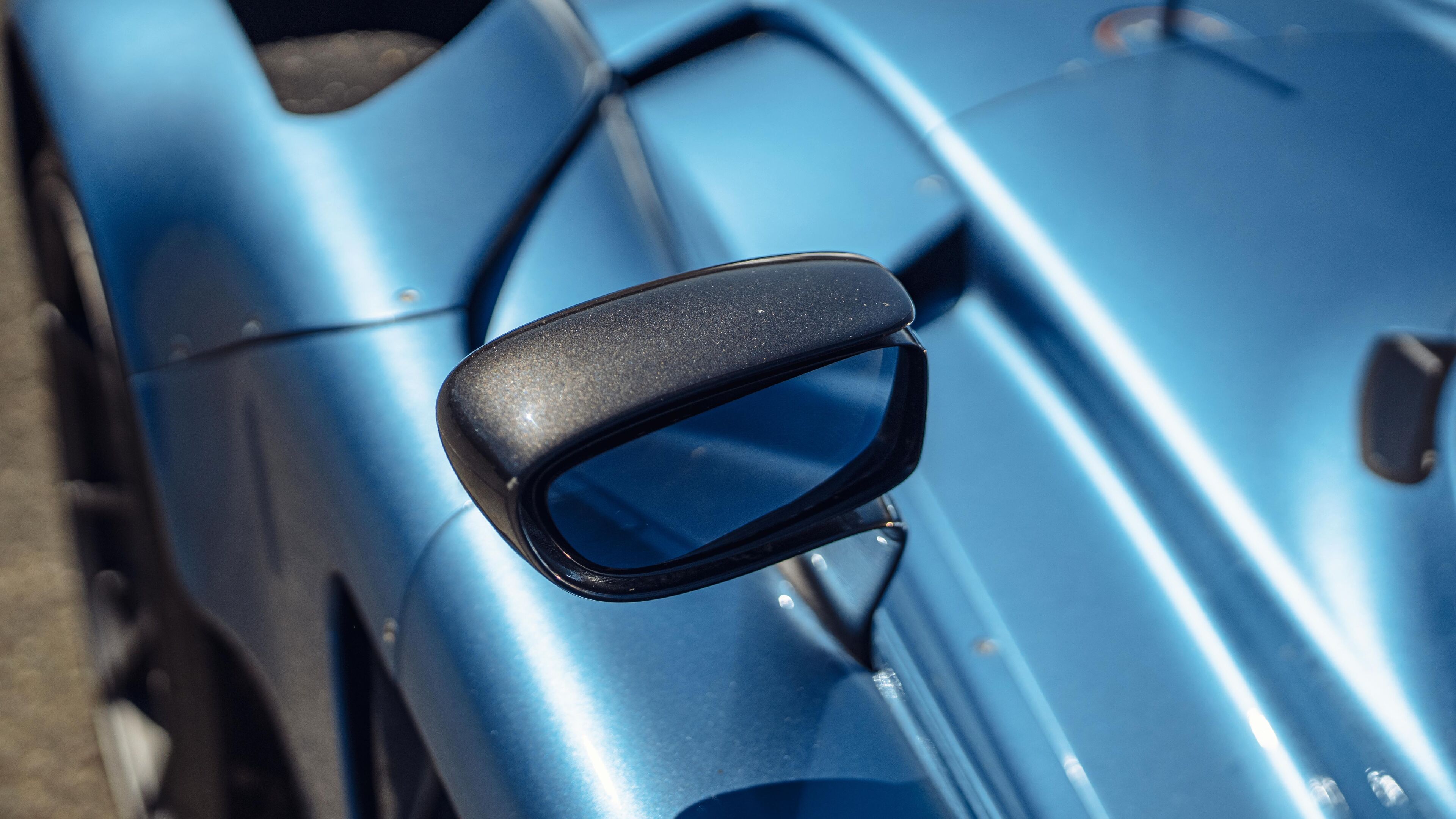
Flat out in the McMurtry Spéirling: "a three in one destroyer of motorsport reputations"
If you thought supercars and hypercars were the pinnacle of performance, think again. The Spéirling is in another league, and can crush them all
“That’s not a car, that’s a cheat code,” whispers our sound recordist Andrei. He’s the only one able to talk. The rest of us have been rendered silent. Somewhere in the distance a fast-receding blue speck flits out of sight.
There is no revolution in car design anymore, goes the common thinking. Everything is incremental. A nudge more power, a tweak more downforce, a modest uplift in speed and grip. A gradual evolution of specification. Nonsense. You want radical? Welcome to the age of the fan.
I’ve never seen or experienced anything like the McMurtry Spéirling. Never driven a faster car, either in a straight line or around corners. In one package McMurtry has created a machine so bizarre it accelerates like a dragster, turns like an F1 car. Better than an F1 car in slow corners. No other car has ever – or probably will ever – do what this one does to low-speed corners. Which is turn them into high-speed corners.
Photography: Mark Riccioni
Which is what happened at Hammerhead. The slowest corner on the TG track, complete with awkward braking, a flick left then hard right, now appears to be some sort of Scalextric corner. Maybe I shouldn’t have gone to watch Max Chilton warming the Batmobile up, because the spectacle is a head scrambler. It’s so fast through the frame of my vision, moving at blurry superhero speeds, that all I can think when I’m left looking at the dirty brown rooster tail of its wake is “how am I ever going to do that”.
The problem isn’t just mine. The silence that followed his passage was also “how do we film or photograph something that moves so fast”.
We’ve all watched the Goodwood hill record. And then watched it again because we must’ve had YouTube on 1.5x speed first time round... 39.08secs. And that was in the first-gen car. This gen Spéirling Pure is faster. To give it some perspective, that Goodwood run was 2.5secs faster up the hill than any F1 car has ever been, getting on for a second quicker than the next fastest, VW’s ID.R Pikes Peak.
Another car I’ve been lucky enough to drive. A car that gave me G-LOC in corners – the stuff that fighter pilots have g suits to combat. That car loomed in my thoughts in the run-up to driving the Spéirling. I’ve never forgotten it. Not just for the outlandish grip, but the way it span all four slicks from a standing start. Later the rear drive only McMurtry will sear off the line significantly faster and without a wisp of tyre smoke. How does it do that?
The Spéirling’s secret is in how it separates drag from downforce. In conventional racing cars one is a corollary of the other – the more downforce you have the more drag – increasing fuel consumption, limiting acceleration and so on. Ideally you want the downforce that gives the tyres more grip, but you don’t want the drag.
Welcome to the crux of F1 aerodynamics. Where suction fans are nothing new. Remember Gordon Murray’s Brabham BT46B? That was in danger of dominance, so it didn’t last. Fans (the spinning type, not the flag waving ones) have never been allowed back in. But physics hasn’t changed, the tech still works. Fit it to a road car? The fans are there to create suction, which means they have to suck against something, and if that something is a regular road with drain covers and potholes full of loose stones, well, you can see the limitations. Just ask Carlos Sainz Jr.
But if you can’t use it for racing, and it’s impractical for the road, what do you do with this miracle force? Well, wait for track only hypercars to become a thing and design something utterly unique. For starters it’s tiny, thigh high and shading the same amount of ground as a 1960s F1 car, designed that way to make the smallest possible hole in the air. Shorn of the dive planes, spoilers and aero flicks everyone else uses, it’s less brawny and aggressive. Cute, almost.
If it didn’t have the conventional rear wing you might almost think it was designed as an efficiency test bed, more akin to VW’s XL1. That wing, by the way, wasn’t there originally, but helps move the centre of grip rearwards, meaning you’ll get friendly understeer rather than scary oversteer.
Top Gear
Newsletter
Thank you for subscribing to our newsletter. Look out for your regular round-up of news, reviews and offers in your inbox.
Get all the latest news, reviews and exclusives, direct to your inbox.
I’m not allowed to see what goes on underneath – 16 patents have been already granted, with more in the pipeline. Most of the sensitivity is around the skirt (especially the membrane that touches the surface) and the filtering system. The Spéirling, after all, is basically a giant self-contained bagless vacuum cleaner.
I get on my hands and knees and have a closer look. A patch directly under where the driver sits, and roughly the same dimensions, is in contact with the ground. Within it McMurtry’s CEO, Thomas Yates (an ex-F1 engineer, like many of his colleagues), tells me that ducts run up on either side, the air drawn through filters in the flanks that stop the grit, twigs, leaves and stones being machine gunned out the neat little exhaust ports in the rear end.
The two fans that are arguably more the heart of this car than the twin electric motors that drive the wheels are high up behind the driver and spin at up to 23,000rpm. Turn them on and the Spéirling will easily stick itself to the ceiling. Standing still.
That’s the trick here. The downforce, up to 3g of cornering force, is there all the time. And in every direction. Start to slide or spin in a winged car and the air is no longer travelling over the aero elements as the designers intended. Go backwards and you’ve got lift, with horrifying consequences. But if something goes wrong in the Spéirling... “just nail the brakes. You’ll come to a stop in a couple of car lengths", I'm told.
Nevertheless I’m intimidated by its reputation, by the radical engineering. I stand there in my race togs, dripping with leads and cables, feeling like an astronaut headed to the launch pad, and try to imagine what it’s going to be like and... well, it’s a head scratcher.
But I never thought it would be a laugh. And it genuinely is a proper hoot. It doesn’t even take me long to get used to the forces before I’m hurling it into Chicago – usually a 50mph entry – at well over 70mph, and roaring with laughter. It takes me a while to puzzle it out. Partly it’s that the Spéirling is so alien, so far beyond anything else that my existing references are broadly irrelevant. Partly it’s because the size, weight, suspension and steering inspire confidence. But it’s why they inspire confidence that’s key – and that’s due to the downforce. Which is utterly consistent.
Because the truism for amateurs like me is that you never quite know where you are with regular downforce. The faster you go the more of it there is, but where are you on that sliding scale? Do I need to go looking for more of it? Or is that a bad idea? What happens as it bleeds off under braking? Will the wheels lock? What’s going to come unstuck first? It’s all rather complex and you find yourself doing a lot of mental gymnastics while driving. But here it’s simple: 3g at any speed, through any corner.
And your internal gyroscope gets up to speed on what that feels like pretty quickly. And it feels good. You know how grippy a go-kart is, and yet how soon you acclimatise? Well, it’s the same here, now all you’ve got to worry about is processing the rate everything is coming at you.
Let’s take a breath and rewind. Because it’s an odd thing to climb aboard. The door aperture is small, and I need someone to help with the harnesses because there isn’t a great deal of wriggle room and I want those belts done up tightly. The doors, containing LMP1 crash structure plinths, are closed hemming me in. The windscreen wraps tightly. There’s barely room for a GoPro. It should be claustrophobic, yet the view out, though confined by the close set wheels, is decent.
Now it’s quiet and I have the calm voice of an engineer in my ear, I settle. The last instruction before the capsule door shuts and I whisper “God speed” into my helmet is a reminder not to wander too far off line where a few manhole covers and brutal surface changes lie. It’s super simple to drive – there are two pedals, two paddles and two key knobs. Electric motors engaged, fans off, it pulls away effortlessly.
I’ve already decided the best way to get to know the Spéirling is by slaloming up and down the runway, just getting a feel for the grip. The two rotary controls operate motor power and fan speed, the idea being that you ramp up through GT3-comparable speeds, to LMP1 and finally F1. Making the Spéirling a three in one destroyer of motorsport reputations.
The fans spool up to 10,000rpm initially. It’s not quiet, a constant jetlike whistle. You expect it to vary with speed, but of course it doesn’t. But you feel what it does instantly. Sucked to the surface, body roll lessens, the steering weights up, the Spéirling becomes firmer, sharper and yet more stable and planted. A few minutes of this and I’m driving it like a hot hatch, it’s playful and engaging, the grip already immense.
Next step: LMP1. Now it gets serious. Set fans to 18,000rpm, power to something ferocious. And yet because there’s more grip than thrust, I’m happy searching for the limits. A couple of times I manage to make it squirm by overdoing it into corners, but its behaviour when the slicks finally give out is natural. It’s just the rate everything comes at you that’s dizzying.
Maybe that’s why I start laughing when I hit maximum attack, the 23,000rpm and 1,000bhp F1 mode. The thrust is unbelievable, it sticks like a suction cup and yet despite the terrifying rate everything comes at me, I’ve always got the brakes. They are every bit as brain scrambling as everything else. Fat slicks carrying 2,000kg of downforce send claws into the tarmac. I have never braked anything like as late for Hammerhead. Or as little. The left/right flick flack happens as fast as my hands can turn the now heavy, heavy steering. It’s absurd. Almost an out of body experience because nothing else is able to do what this does. Inside I am the superhero.
At one point I chase the GT3 RS around, toying with it. It’s flat out, yet barely moving
At one point I chase the GT3 RS around, toying with it. It’s flat out, yet barely moving and I’m thinking, “Ha! Puny weakling, I will now destroy you as easily as squashing an ant”. And I do, screaming off into the distance, leaving it choking on the dusty memories of my passage. And I realise two things: 1) never has speed and approachability been better blended and 2) given ultimate power, I’d handle it badly.
The drag race between the two is equally hilarious. On the first run I forget to rest my head back and receive a one-inch punch when the flag drops, smacking my helmet back. It pulls 2g off the line, hits 60mph in 1.38secs, 100mph in 2.61secs. It accelerates like a flicked pea.
It’s all completely ludicrous. I’ve driven so many dizzyingly rapid cars, but nothing has ever smashed the limits so far into the distance as this. And yet it’s connected and engaging. It’s a happy little car, this rocketing roller skate, never tries to show you how fearsome its performance is, just takes you along for the ride. It’s captivating.
The question is what do you do with it? Track days, I suppose. I mean, it’s gonna be like Outrun out there as everyone spools towards you. The likelihood is that many of the 100 being built will be converted to road use in some capacity. With that in mind, it feels too much like a racer at the moment. The cabin needs a cleaner aesthetic, to feel more akin to other hypercars. That’s the audience it’s going for.
Me? I survived. You’d survive too. Sometimes I had to rest my head through corners, but that’s what the plinths are there for. And you don’t have to go flat out. But you find yourself wanting to. Giving yourself over to the grip. We’ve said grip is dull, but not when it’s this exuberant, this riotous, this exhilarating. It can push you as hard as you could ever want to be pushed. Welcome, then, to the wonderful world of the McMurtry Spiérling.




